Arctic fires worsen and threaten world famous park set up to recreate flora of woolly mammoth era
Worrying videos and pictures show how the pristine polar region of northern Yakutia is ablaze.
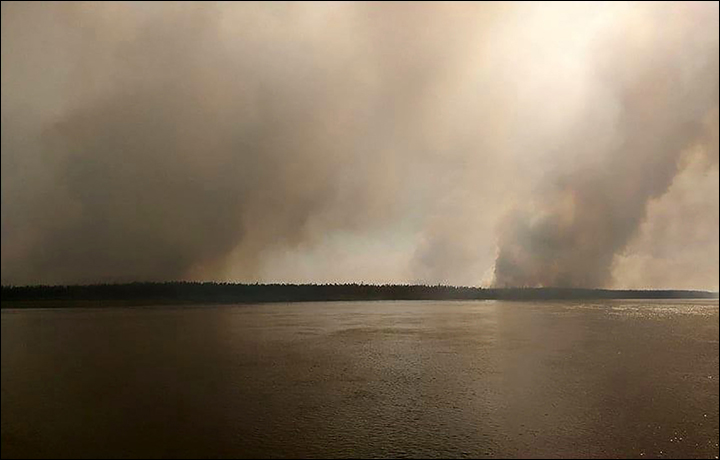
Banks of mighty Siberian River Kolyma are hardly visible through the clouds of smoke from wildfires. Picture: Vera Salnitskaya
Siberian Times,
1 July, 2020
A major fire is burning right now outside the Arctic town of Chersky, around
Mount Rodinka, loved by the locals for weekend trips.
1 July, 2020
A major fire is burning right now outside the Arctic town of Chersky, around
Mount Rodinka, loved by the locals for weekend trips.
The fire started around 10 days ago, threatening a major power line that feeds the remote town.
There was a hope that the fire was stopped some 10km from Chersky, but today
the director of Pleistocene Park Nikita Zimov said that the blaze was back.
the director of Pleistocene Park Nikita Zimov said that the blaze was back.
He shared a video of clouds of smoke blanketing the sun around the park deep
in eastern Siberia.
in eastern Siberia.
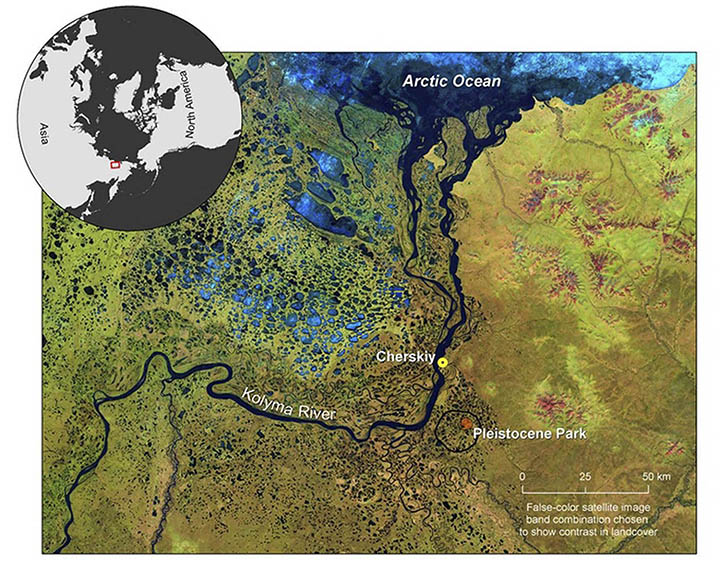
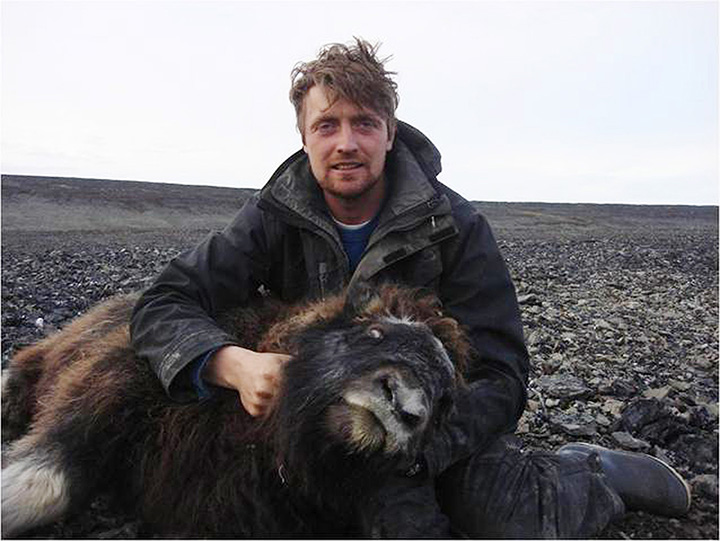
Arctic on fire. Wildfires around the town of Chersky, a gateway to the Pleistocene Park pictured and filmed by Nikita Zimov and Alexei Kurilo
The park is a major ecological experiment recreating the northern subarctic steppe grassland ecosystem that flourished in the area during the last glacial period.
Its supporters say such a back-to-the-future change by restoring grassland and
creating an Arctic Serengeti can show the world how to significantly slow the
release of dangerous carbon gases into the atmosphere in regions where
permafrost is thawing after being frozen for tens of thousands of years.
The park is also seen as the perfect home for woolly mammoths if scientists
succeed in current efforts to bring the species back to life by genetic cloning from remains preserved in the permafrost in the region.
Worrying pictures came this week from aboard a ship moving along Kolyma River
from the town of Srednekolymsk, with banks of the mighty Siberian river barely
visible because of smoke from wildfires.
People from Yakutsk said that while they don't see the fires around the city yet,
they certainly begin to feel the smoke.




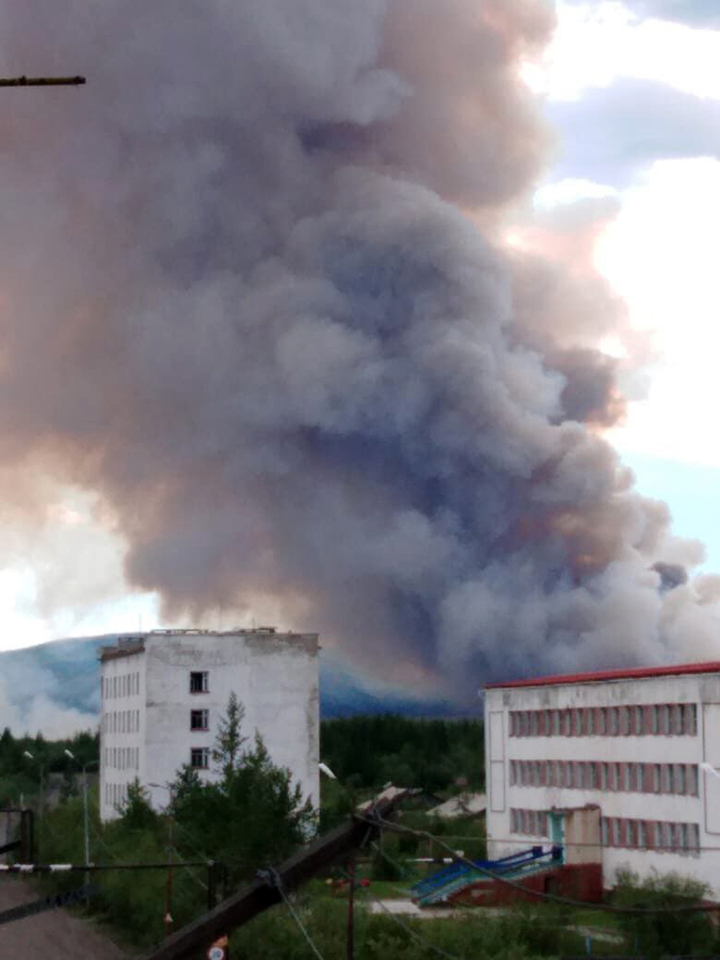
Pictures of wildfires in the extreme north of Yakutia from around the towns of Chersky,
Srednekolymsk and Nizhnekolymsk. Pictures: Nikita Zimov, social media
Lena Pillars Park in Yakutia south from Yakutsk said earlier today that they had to postpone re-opening despite coronavirus restrictions being lifted because a state
of emergency was introduced at Khangalassky Ulus due to the extremely high
number of wildfires.
'A very strange' July was forecast for Yakutia by Russian weather specialists.
Average temperature will stay for at least seven, ten degrees C above the norm,
with rains not coming until around 20 July.
The end of the month will 'cool down' to about +20C, while the first 20 days of
July might be as hot as +30C - and dry.

Residents of Yakutia enjoy hot summer days in Yakutia’s desert of Tukulany.
Picture: Ilma Sevostyanova
Picture: Ilma Sevostyanova
Massive wildfires in the extreme north of Siberia will continue more and more often, warned Russia's chief weather specialist Roman Vilfand.
'Forests are on fire all along the Arctic territory including Alaska and Canada,’ he
said.
‘It's linked to changes in circulation and to the increasing number of meridional processes that lead to forming of stationary anticyclone’.,
Vilfand explained that two other key factors contribute to a current massive spike
of Siberian and Arctic wildfires: the sun doesn't set during Arctic summers and
ground doesn't cool down, and secondly it keeps getting heated by clear weather
with little or no clouds.
Currently wildfires rage in the remote areas of Siberia at the combined territory of
more than 1.5 million hectares, according to Russian Aerial Forest Protection
Service.
The pole of cold town of Verkhoyansk experienced a ‘fantasical’ temperature of
38C on 17 June, he said.
The northernmost fire of 2020 to date caught by satellites above the Arctic
circle, and the mid-June 2020 Arctic heatwave. Pictures: European Union , Copernicus Sentinel-2 imagery
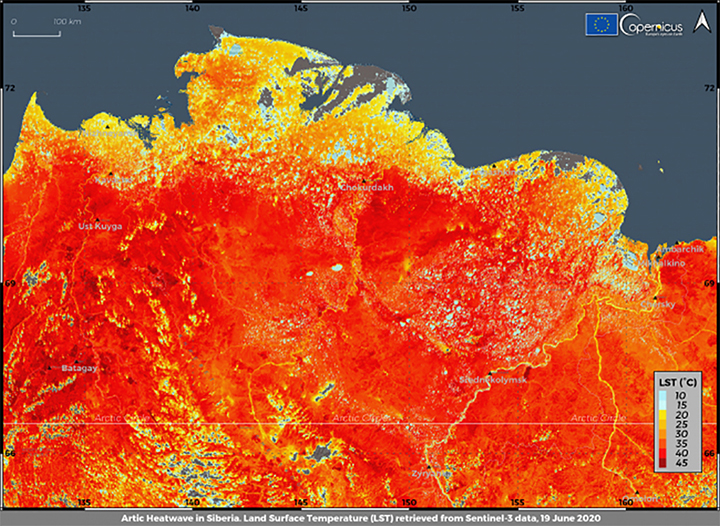
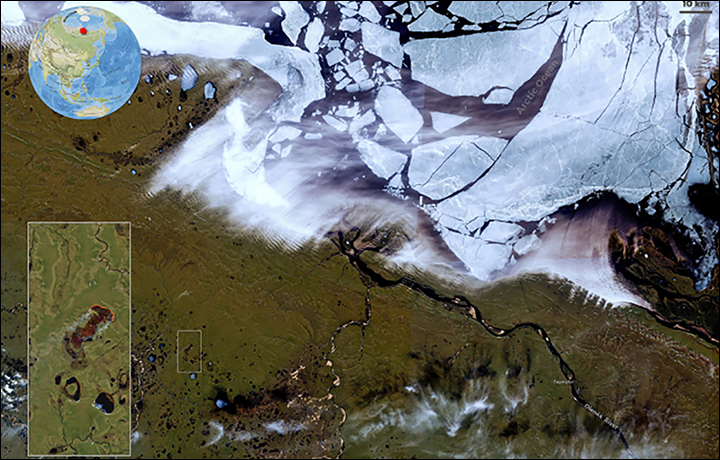
Arctic wildfires burning
further north than previously
spotted from space, satellite
shows
Blazes raging just 50km from the Arctic Ocean in Yakutia.
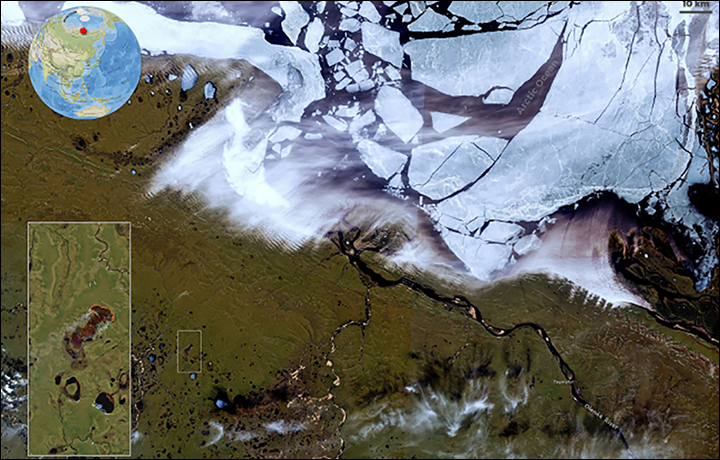
27 June, 2020
The northernmost fire of 2020 to date caught by satellites above the Arctic circle. Picture: European Union , Copernicus Sentinel-2 imagery
An inferno has been spotted at Latitude 72.723° N, Longitude 118.12° E by the European Union’s Copernicus Sentinel-2 satellite, in the Anabar district,
southwest of the Olenyok River estuary into the Laptev Sea.
The fire is believed to be ‘the most northernmost in recent years within the Arctic
Circle’, according to the EU’s Earth Observation Programme.
‘While fires are common at this time of year, record temperatures and strong winds are making the situation particularly worrying,’ said a statement.
The fire is 12 km further north of an inferno registered last year by the same
programme which uses infrared sensing capabilities to detect active fires.
The Aviation Forest Protection Agency in Yakutia, also known as the Sakha
Republic, the largest region in the Russian Federation, reported 127 natural fires covering 822,724 hectares.
Pictures and video here shows fires burning in the far north around Chersky in the north of Yakutia.



Pictures and video here shows fires burning in the far north around Chersky in the north of
Yakutia. Pictures: Nikita Zimov, video credit Ulus media
A major effort is underway to protect remote settlements with main concern in
Abyisky, Verkhnekolymsky, Verkhoyansk, Zhigansky, Mirninsky, Srednekolymsky, Tomponsky and Eveno-Bytantaysky districts.
The fires are burning both north and south of the Arctic Circle.
Pleistocene Park - a project to recreate the flora of the woolly mammoth age -
was under threat with fires 20km away.
Director Nikita Zimov said: “It’s a good thing the weather changed and the fire
(here has) pretty much stopped by now."
Recent reports include soaring temperatures in one of two poles of cold in Siberia, Verkhoyansk, within the past week.
Thermometers hit 38C(100.4 degrees Fahrenheit).
‘The Arctic is figuratively and literally on fire — it’s warming much faster than we
thought it would in response to rising levels of carbon dioxide and other
greenhouse gases in the atmosphere, and this warming is leading to a rapid
meltdown and increase in wildfires,’ said University of Michigan environmental
school dean Jonathan Overpeck, a climate scientist, reported AP.
‘The record warming in Siberia is a warning sign of major proportions.’

Arctic heatwave in Siberia, picture from 19 June 2020. Picture: European Union , Copernicus Sentinel-2 imagery
Such prolonged Siberian warmth’s not been seen for thousands of years ‘and it is another sign that the Arctic amplifies global warming even more than we thought’, he said.
Pictures highlighted this week by The Siberian Times showed the impact of thawing permafrost on a building in regional capital city Yakutsk.
Cracks suddenly appeared as the frozen foundations caved in.
A major 21,000 ton diesel leak occurred near Norilsk, in Krasnoyarsk region, due to permafrost thawing.
Another oil leak came in Yakutia region.
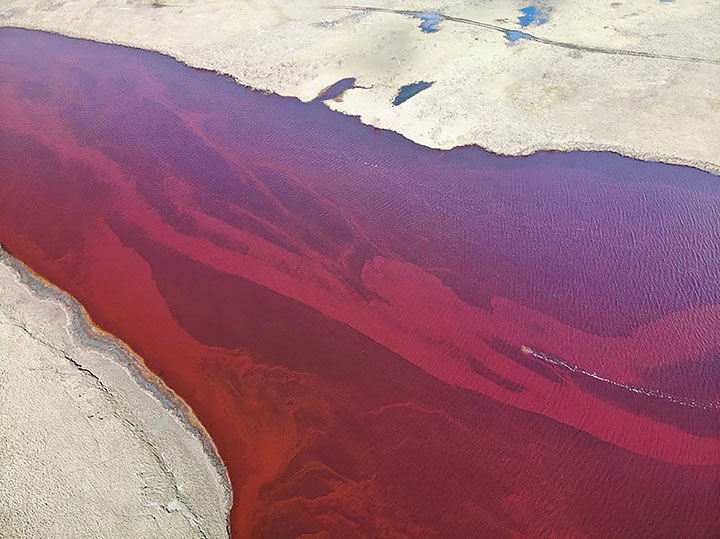
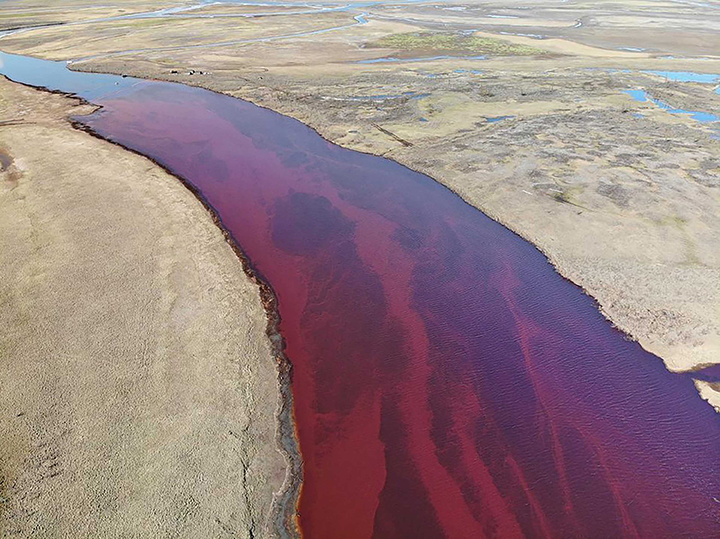
2100 tonnes of diesel leaked on 29 May 2020 into a system of rivers ourside Norilsk that lead to the Arctic Ocean. Pictures: Vasily Ryabinin
Russian Academy of Sciences’ President Alexander Sergeyev said: ‘We should organise a total monitoring of both industrial and housing buildings on the
permafrost.
‘If the permafrost degrades, all those building will begin to slide.
‘This task is of the highest importance.
‘I hail the idea, which has been supported by President Vladimir Putin, to have a
new programme to monitor the climate and consequences from the climate changes.’
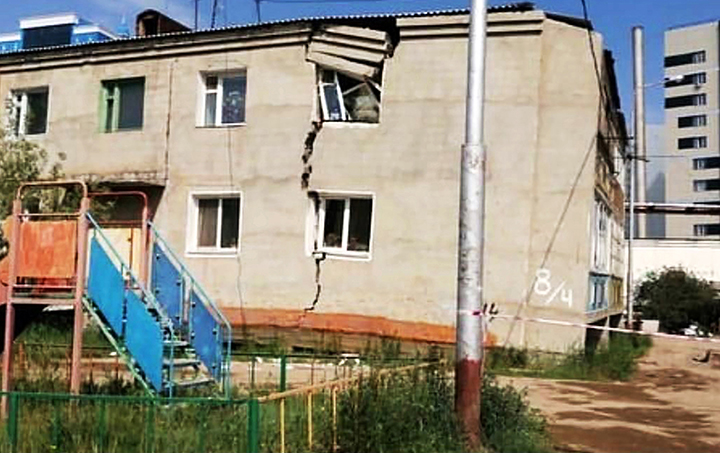
Cracks 10cm wide appeared inside three flats and on the outer walls of the residential block at 8/4 Avtodorozhnaya Street in the outskirts of Yakutsk. Picture: News Ykt
Abnormal heat is predicted in Yakutia and Krasnoyarsk regions until the end of
June.
The scientific director of the Hydrometeorological Centre of Russia, Roman
Vilfand, said temperatures range 12 to 14 degrees above normal.
This is due to a stationary anticyclone, the meteorologist noted.



No comments:
Post a Comment
Note: only a member of this blog may post a comment.